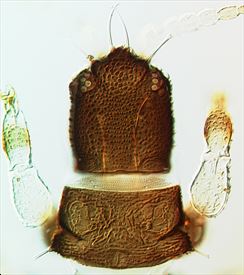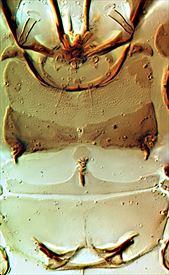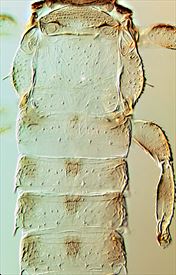Distinguishing features
Both sexes apterous (female rarely fully winged). Head, pronotum, and mesonotum dark brown; abdomen pale with brown markings on lateral and median areas; legs usually pale, fore femora variably brown or entirely pale; fore tibiae pale in males; antennal segments I and VI–VIII brown, II–IV pale, V either pale or brown; tube darker at apex; fore wings (when present) pale. Head longer than wide; dorsal surface tuberculate; anterior margin overlying bases of antennae, bearing 3 pairs of long, expanded setae, of which the median pair is longest and the 2 lateral pairs arise close together; compound eyes small, usually with 5 or 6 facets dorsally and 3 ventrally; no ocelli nor postocular setae; maxillary stylets about one-third of head width apart, retracted to compound eyes; maxillary bridge present. Antennae 8-segmented; segment III with a distinct pedicel but no sense cone, VII and VIII closely joined; IV with 2 long sense cones. Pronotum strongly sculptured, with 1 pair of short, stout epimeral setae; basantra small, lateral. Metanotum with scattered small setae, unsculptured; metathoracic sternopleural sutures absent; metathoracic epimeral setae similar to prothoracic epimerals. Abdomen: tergite I broad, not reduced to a pelta; tergites faintly sculptured medially, with a transverse row of discal setae; tergite IX about twice as long as VIII; tube exceptionally long and slender; terminal setae long, fine, the dorsal pair only half as long as the lateral 2 pairs. Female macroptera with tergites II–VII bearing wing-retaining setae; fore wings narrow, broader in basal third, with no major sub-basal setae; wing cilia widely spaced, without duplicated cilia.
Male similar to female aptera, but smaller; head with only 1 pair of lateral setae on anterior margin; no sternal plates.
Related species
There are 12 species listed worldwide in the genus Baenothrips. These are mainly from tropical countries, with two from Australia, of which only B. moundi is recorded from New Zealand.
Biological data
Living at the base of grasses, and also on dead twigs and branches, and presumably fungus-feeding.
Distribution data
Widespread across Australia, this species is also found widely across New Zealand (Three Kings Is / ND, AK, CL, WO, TK, TO, BP, HB, WN / SD, MB, KA, NN, BR, MC, CO, DN, FD / Chatham Is.).
Family name
PHLAEOTHRIPIDAE, PHLAEOTHRIPINAE
Species name
Baenothrips moundi (Stannard)
Original name and synonyms
Transithrips moundi Stannard, 1970: 121
References
Mound LA (1972) Species complexes and the generic classification of leaf-litter thrips of the Tribe Urothripini (Phlaeothripidae). Australian Journal of Zoology 20: 83-103.
Mound LA & Walker AK (1986) Tubulifera (Insecta: Thysanoptera). Fauna of New Zealand 10: 1–140.




